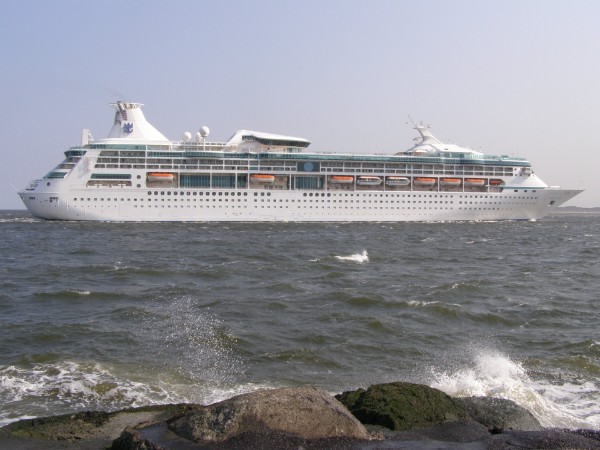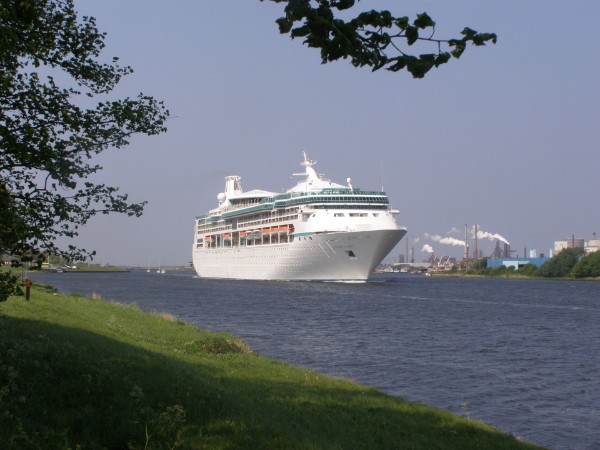Vision Of The Seas
Background

Vision Of The Seas as seen from the southern pierhead at IJmuiden at the 30th of april, 2011.
From the mid 1980's onwards, after the cruise-industry started to grow much more then anticipated before, Royal Caribbean Cruise Line had become a fast growing company. They had started up in the early 1970's, based out of Miami, Florida. But as more parts of the world came into view and the company re-structured themselves after an almost hostile take-over by competitor Carnival Cruise Line, more money became available and expansion of the brand was a logical step. In the late 1980's, the company had built the largest cruiseships to date, the Sovereign-class. Those ships of 74.000-tons finally equalled Norwegian Caribbean's Norway and it became clear that larger cruiseships were an option. With the three magaships being an instant success in the Caribbean, RCL came up with the radically changed 'Project Vision' as their follow-up to cope with the growth and to tap into other markets.
What's in a name?
Mostly, the name-giver of a class of ships is the first ship to be built. In that way, it is an easy reference. Royal Caribbean International is a little more confusing, though. The Vision-class of ships, that is a class of four (or six), started with the Legend Of The Seas and the Splendour Of The Seas, which are of a totally different design then the other four and that is why I don't see them as Vision-class. The later four, Grandeur Of The Seas, Rhapsody Of The Seas, Enchantment Of The Seas and Vision Of The Seas, are almost identical and can be called one class. Of them, the namegiver Vision Of The Seas was built as the last one. But between those four, there are also differences in size, with Vision and Rhapsody being 78.000-tons and Grandeur and Enchantment being 74.000-tons.
The next class of ships, starting with the Radiance Of The Seas, is officially the Vantage-class. There is no 'Vantage Of The Seas'. The two classes that were built after the Vantage class were named the Eagle-class and the Voyager-class, and the Voyager-class was the largest of the two. But when the first ship of the Eagle-class was launched, her name was Voyager Of The Seas. So this class was renamed as Voyager-class, and the original one was named Freedom-class, after the first ship that entered service as Freedom Of The Seas. Enough chitchat, back to Vision.
Construction and general statistics
As the last ship of the class, Vision Of The Seas measured 78.491 tons, the same as one of her earlier sisters, the Rhapsody Of The Seas. She was built at Chantiers de L'atlantique at Saint Nazaire in France as yardnumber F31. The ship has a lenght of 279 meters, she is 32,30 meters wide and her draft measures 7,60 meters. Her maximum passengernumber is 2441, based on lower berths the number given is 1998. They are cared for by some 765 crewmembers on ten passengerdecks. When launched, the ship was registered at Liberia, her homeport being Monrovia. She was laid down at the 29th of october in 1996, launched at the 1st of september in 1997 and finally delivered to the company at the 15th of april in 1998.
The picture below is from the same day as the first one, only now she is seen sailing towards Amsterdam near the village of Velsen-Zuid.

Design
I already mentioned that the Vision-class was quite radical, which probably is something you do not think it is. But first of all, RCL gave these ships quite a bit larger cabins then they were used to do. Normally, on the older ships including the new giants of the Sovereign-class, RCL made the cabins small to encourage passengers to go into the public spaces of the ships and spend their money there. This was altered in the Vision-class and the cabins became more standard-sized. As mentioned also, the name 'Vision' wasn't used for the first ship but it was more given because the ships would get much more glass on the outside then before. They even went as far as making half of the ships exteriours (around 7300 square meters) out of glass, especially visible in the Centrum. Two full decks of cabins also recieved balconies, more then doubling the number of balconycabins in comparissement with the Sovereign-class.
The passengers have 12 decks to relax on, of which five are lined with passengercabins. There is eight types of those and nearly a quarter out of the total of 999 (229) have a balcony and 60% of them are outside facing. There are 18 suites and 14 cabins are wheelchair accessible, just like all of the suites.
The main hub aboard is the very airy and roomy Centrum, spanning six decks. There also are several lounges, one at the top deck gives spectacular panoramic views inside the traditional Viking Crown. A change from earlier ships, the crown is not wrapped around the funnel but more midships, to make it easier accessible from the ships Centrum.
The ships also became very fast. In fact, they became the fastest passengerships in 25 years. This mainly because of the new diesel-electric engines that were placed more in the middle of the ships hull to create a better balance thus better waterflow. These engines were the first of its kind in the Royal Caribbean fleet.
Carreer
The ship was delivered to the company at the 15th of april 1998 and named at Southampton on the 26th of april. Her godmother is Helen Stephan, the wive of Edward Stephan, one of the founders of the company and its vice-chairman. After the naming ceremony, the ship sailed her first official cruise starting on may 2nd from Southampton, and settling in into a season of European cruises. After her first season in Europe, she was placed in other services before returning to European summerseasons from 2009 onwards. She is then mostly based at Copenhagen, Oslo or Stockholm and she sails cruises in the Baltic, around Great Britain or off to Spain. In winter, the ship takes on Caribbean cruises from Fort Lauderdale.

